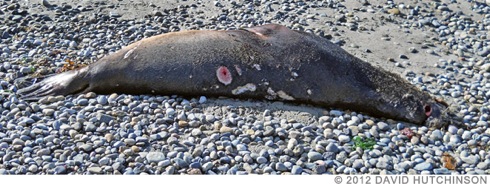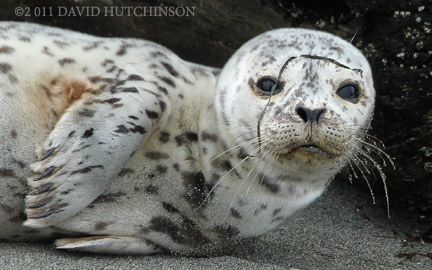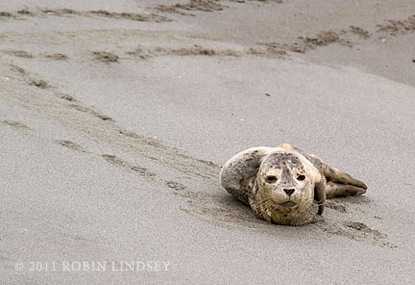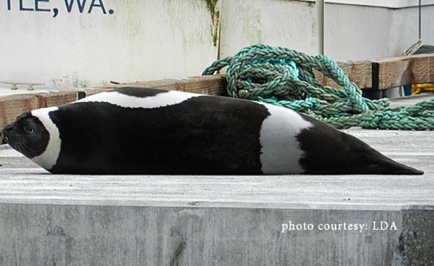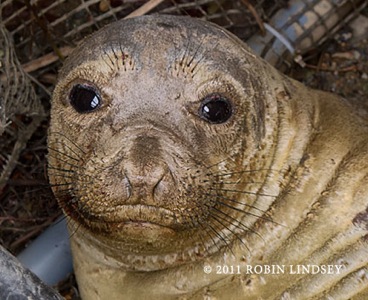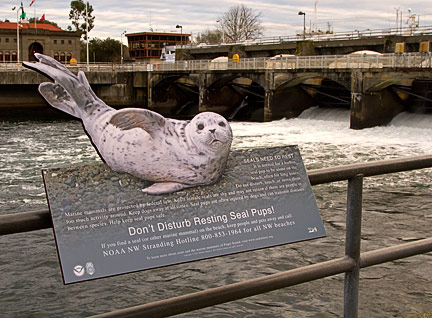Jan/31/12 05:52 PM
On August 14, 2011, Seal Sitters MMSN responded to a pup in West Seattle that was just a few weeks old and named her Sandy. The pup spent that night on the beach under observation. The next morning, the pup was extremely weak and barely responsive, with numerous infected wounds and no apparent mom. She was severely dehydrated and malnourished to the point of emaciation. Seal Sitters transferred her to PAWS Wildlife Rehabilitation Center for stabilization, treatment and care. On Friday, January 27, after five months of rehabilitation, she was released near a harbor seal haul out in South Puget Sound. Sandy will provide invaluable data to the network.
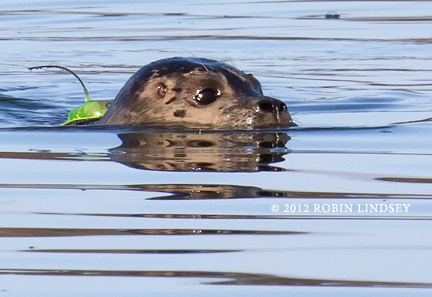
Every year harbor seal pups that strand and are rehabilitated are released back into the wild. Last year, 10 rehabilitated pups provided novel data on how these animals move post release as compared to wild seals. Sandy, an older rehabilitated weaned pup, will be the first of this age class to be tracked by satellite in Washington State. The video above shows her being fitted with a satellite transmitter and released back home to the Salish Sea.
Sandy’s movements will provide ground-breaking information for biologists. She can be tracked by the public as well on SeaDoc Society’s website, which has a
web page dedicated to her, showing a map of her cruising around South Puget Sound. In the photo above, Sandy swims in the wild with her new satellite hat. Tracking this animal would not be possible without the collaboration of several network groups which include: Seal Sitters MMSN,
PAWS Wildlife Center,
WDFW Marine Mammal Investigations,
SeaDoc Society and
NOAA’s Protected Resources Division.
PUPDATE: Feb 2/2012
We have had some folks with concerns that the satellite tag is somehow harmful for Sandy. The tag is applied with glue to Sandy’s pelt and will fall off when she sheds her fur during molting season in a few months. Most likely, the tag will fall off before then; however, in the interim, the satellite tracking will provide researchers with insights into foraging patterns, distances travelled by weaned pups and health and mortality data. This research will help other seal pups in the future.
Tags: Sandy, rehabilitation, release, satellite tag
Jan/28/12 12:43 PM
Local and international media have picked up our story of the California sea lion necropsy findings, along with NOAA’s newest release of information regarding additional pinniped shootings in Washington State. WDFW Marine Mammal Investigations’ biologist estimates the 6-10 year old male had been dead approximately 3 weeks at the time the decomposed body was necropsied at Lincoln Park. Seal Sitters established a perimeter of biodegradable tape and tied the sea lion with rope to a secure log high on shore to ensure the animal would be there the following day for the exam. As this is an on-going criminal investigation, Seal Sitters is not at liberty to divulge details of this case, nor those of the other seals/sea lions. For further information, please contact NOAA Office for Law Enforcement @ 206-526-6133.

Sadly, shootings occur annually in the Pacific Northwest, particularly in fall and winter when large numbers of sea lions move into our area in search of food. Wherever there are large concentrations of fish, there are usually large numbers of sea lions, seals and humans competing for the same resources - and that can often lead to potential negative interactions. In early 2010, there were 14 confirmed and 3 probable
shootings of California, Steller sea lions, and harbor seals within the Puget Sound area. Four of those animals were found on the shores of West Seattle.
Please check back for continued updates on this on-going investigation. You can help protect marine mammals by being vigilant both from shore and by boat, watching for any harassment or violence and reporting to NOAA’s Office for Law Enforcement.
Tags: California sea lion, necropsy
Jan/26/12 09:39 PM
Yesterday, a team from WDFW Marine Mammal Investigations Unit led by biologist Dyanna Lambourn performed a necropsy on a mature male California sea lion. The dead animal was discovered on the beach at Lincoln Park on Monday and photos were sent to WDFW. Seal Sitters’ volunteers and Seattle Parks’ staff secured the sea lion so that he would not be swept away by extreme high tides before the necropsy.
The moderate to advanced decomposed animal had been scavenged by birds and other creatures and had a shark bite wound. Muscle and tissue were closely examined for trauma and hemorrhage; evidence of a “penetrating” wound, suspected to be that of a bullet, was found deep in the tissue and tracked back to the entrance wound. Bullets create small entry holes that are often difficult to detect on the exterior. The head and lungs were removed for further examination and radiographs. That afternoon, a bullet was removed from the left lung lobe. Additionally of note, the intestines were twisted and will be examined - causes can include fishing lures and line, plastics, tumors or possible trauma from the wound. Organ tissue samples were taken for histopaths. WDFW intern and new Seal Sitters volunteer, Allison Reeder (left in photo), assists Dyanna with photo documentation.
NOAA Office for Law Enforcement has been notified and evidence and information will be turned over for investigation.
Tags: California sea lion, necropsy
Jan/26/12 09:15 PM
Several pups have been using our beaches the past few days, enjoying the hospitality of seal-lovin’ West Seattle residents. Two pups were hauled out yesterday, enjoying a sunny, but brisk and windy day - one pup at Lincoln Park and another on a private stretch of beach (this one also showed up later in the day at Constellation Park). Volunteers bundled up, kept vigil and talked to onlookers. Heads up as you walk along the beach!
Jan/23/12 08:02 PM
A couple enjoying a Saturday morning stroll were treated to the sight of a seal pup, resting on a stretch of private beach in West Seattle. They alerted the hotline and our responder headed south to meet one of our volunteers at the site. The pup, who had a lengthy snooze, was very alert with pretty good body weight for a
weaner.
NIcknamed Surprise, he returned to the Sound late afternoon, under the protective watch of volunteers since the beach was accessible by the public until high tide.
Another pup (possibly the same one, but no positive photo id) visited Lincoln Park twice today. We continue to have weaned pups reported across Puget Sound. Seal pups and adults use the shoreline to rest year-round, so remember to be on the alert as you walk the beaches. If you spot a seal, give him as much space as possible, keep people and dogs away, and call the hotline.
Tags: Surprise
Jan/19/12 12:26 PM
Pupdate: The weeks old pup rescued by Seal Sitters from a West Seattle cove on August 15th has finally finished rehabilitation and is ready for release back to the wild. Sandy was terribly thin (photo) and spent the night on the beach. She was taken to PAWS early the following morning. The photo shows her
haul out path and the distinct tracks made by seals when they come ashore. Unable to rotate their rear flippers for locomotion on land like sea lions, harbor seals use only their front flippers and crawl in an undulating motion much like a caterpillar. While awkward and vulnerable on shore, seals are fast and acrobatic swimmers with their sleek, torpedo-shaped bodies.
Sandy will be fitted with a satellite tag. This will provide valuable information to biologists and the hope is that the public will be able to track her movements via the internet as well. Her release had been planned for tomorrow, however, due to snow and ice conditions, it will be rescheduled. Please check back for photos of her release to a South Puget Sound haul out site and information about potential website monitoring. It would be a thrill to be able to follow Sandy’s progress back home in the sea.
Tags: Sandy, rehabilitation
Jan/13/12 10:20 AM
NOAA and Seal Sitters MMSN are on high alert for a rare arctic ribbon seal which was spotted Wednesday resting on a dock in the Duwamish River. The seal is native to the Bering and Okhotsk Seas and parts of the Arctic Ocean, using ice flows for mating, giving birth, and molting. This animal’s presence in our waters is of concern to NOAA; however, the photos submitted seemed to indicate that the animal was in good health. Ribbon seals are considered a “species of concern”, which identifies species that are potentially at risk. There is no planned intervention if the animal is re-sighted, but instead he will be monitored closely by the stranding network. In 1962, a ribbon seal was
reported near Morro Bay, California. Read more about ribbon seals
here.
If you spot this distinct seal, please stay back and call Seal Sitters’ hotline @ 206-905-7325 or Kristin Wilkinson of NOAA @ 206-526-4747.
Tags: ribbon seal
Jan/13/12 09:59 AM
A juvenile elephant seal surprised workers at a Commencement Bay waterfront business Wednesday morning. WDFW Marine Mammal Investigations Unit, the stranding network for a huge geographic territory in South Puget Sound (
see map), had received a call Tuesday about a large seal resting on the beach at a marina. The elephant seal returned to the bay at high tide that evening. The following morning, the network received another call about the seal at an adjacent marina. This time, the seal startled a maintenance worker who lifted a hatch on a wooden walkway to access an area underneath the building, which sat on stilts. Much to his astonishment, the seal was nestled in among pipes and netting. Seal Sitters’ responder was in the area (having delivered a dead seal pup to WDFW for necropsy) and she jumped at the chance to check out the “ellie” seal for them.
The young seal appears to be healthy, but is going through a
molt, where the first layer of skin and fur is shed over a period of about a month. It can be a very gruesome looking ordeal and seals typically remain onshore during this time without returning to the water to forage. However, once the molt is complete, she will be covered with a new, silky fur coat to protect her from our cold waters. The ellie had picked a very quiet place to molt, but how had she managed to get in there? Our responder went around and under the building to make sure she had an exit from the area if the tide table was too high. Indeed, she had a clear exit to leave if necessary. The employees were excited to have this unusual visitor take up residence to complete her molt, safe and undisturbed. Read more about molting
here.
Northern elephant seals are the largest pinniped found in NW waters. The breeding rookeries are located in California and Mexico; however, after the winter breeding season and annual molt, individuals disperse northward along the Oregon and Washington coasts. Small numbers have settled in Puget Sound and use beaches at Destruction Island, Protection Island, Smith and Minor Islands and Dungeness Spit. Births of pups have been recorded at these sites as well.
Tags: elephant seal, molting, molt
Jan/08/12 06:03 PM
Seal Sitters’ informational beach signage about harbor seal pups has been extended throughout the region thanks to Kristin Wilkinson of NOAA. As Kristin states, “The signage project is a very important part of the Northwest Marine Mammal Stranding Network. Our goal is to educate the public about marine mammals in the area, what their normal behavior is, and who to contact if they come across a stranded animal on the beach.” Seventeen signs are currently being installed on beaches at locations including the Ballard Locks (photo left), Golden Gardens, Seattle Art Museum’s sculpture park waterfront, Discovery Park, Carkeek Park and the cities of Shoreline, Edmonds and Mukilteo.
The
successful signage project was originally initiated by Seal Sitters in 2010 as a result of Seattle Department of Neighborhoods matching fund awards. Twelve signs (2 versions) were installed along the shore of West Seattle in the fall of 2010 and late spring of 2011. The sign version shown here features Spud, the seal pup who appeared on West Seattle’s Alki Beach in August of 2007, inspiring the formation of our network.
Tags: signage
Jan/08/12 06:00 PM
Bubbles and two other (yet unidentified) pups have been periodically using the beach since New Year’s Day. However, we have not sighted Bubbles in the past few days.
Jan/01/12 05:14 AM
Seal Sitters celebrated New Year’s Eve with the arrival of our 51st pup of 2011, nicknamed appropriately enough, Bubbles. The pup hauled out yesterday afternoon, but thankfully returned to Elliott Bay around 10:30 - before crowds had gathered along West Seattle’s shore to view the fireworks celebration. Bubbles was alert (which is always a good sign), but did manage to get in a long snooze and we hope to see the pup again today. It was an uplifting end to the year for our volunteers.
Tags: Bubbles

